|
MAJŌ DENSETSU II: DAIMASHIKYŌ GALIOUS
|
|
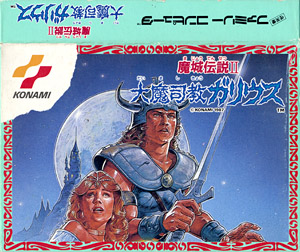
|

|
|
魔城伝説II 大魔司教ガリウス
©Konami 1987
Release: 1987-08-11 (¥4900)
Cartridge KDS-GI
Adventure/Action Game
|
Majō Densetsu II Daimashikyō Galious is an action/adventure game by
Konami and sequel of Majō Densetsu Knightmare originally released
for the MSX in 1986. In the first episode, the evil Hudnos
kidnapped the poor Aphrodite and kept her prisoner in the dark foreboding
Atos mountain. The courageous Popolon decided to venture out to
rescue his beloved wife, but there he discovered that it was just a malicious
trap. While he was away, the hideous Galious attacked his homeland and
kidnapped his yet to be born child Pampas. He and Aphrodite, now
reunited, embark on a long quest to save their baby's soul. Galious's
castle is a huge place that connects five large dungeons, all filled with deadly
traps and fearsome monsters. The player controls both heroes and can alternate
between Popolon and Aphrodite at anytime during the game - while
Popolon is capable of greater strengths (he can do higher jumps or
destroy blocks in one hit), Aphrodite takes significantly less damage
when underwater and can shoot more projectile weapons at once than him.
Additionally, Popolon and Aphrodite have their own health and
experience points (the latter slowly increase as they kill foes) but share
the same equipment. The goal of the game is to find and defeat the five bosses
hidden in each dungeon and to steal their Great Keys. But the task at hand
is a daunting one and the couple will have to retrieve all kind of new weapons
and items to succeed, such as more powerful swords (allowing them to destroy
certain blocks) and a myriad of magical items giving them special abilities.
Each dungeon also features a set of items that can be collected in order to
ease exploration or to defeat the boss, such as the Map, the Seisui/Holy Water
(doubles damages inflicted to the boss), the Cloak/Mantle (halves damages
inflicted by the boss) and the Magical Rod (gives the player infinite
ammo for the boss fight). Majō Densetsu II Daimashikyō Galious is
a vast game and features a password system to save the player's progress.
|
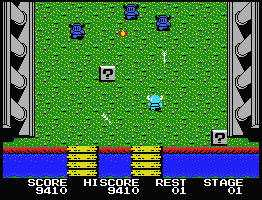 Majō Densetsu II Daimashikyō Galious is part of a game trilogy released
mainly for MSX Japanese computers. The first opus, called Majō Densetsu Knightmare
was released in 1986 (picture on the right). It was a vertical shooter and starred Popolon, a courageous knight
on a mission to deliver his beloved Aphrodite kept prisoner in the depths of Mount
Athos by the evil Hudnos. The game was very innovative for its time and the unique
blend of fantasy elements and shooting action gave it a sort of cult-following status in Japan.
Knightmare was later included in the Konami Game Collection 1 released for the
MSX2 in 1988 (this version apparently features enhanced music when using Konami's
SCC sound cartridge), in Konami Antiques MSX Collection Vol.2 (Sony Playstation, 1998)
and Konami Antiques MSX Collection Ultra Pack (Sega Saturn, 1998). Konami
even re-released the game in 2003 for Japanese cell phones. Two fan made games are also worth
mentioning - the brazilian Knightmare Gold was released in 2005 and added numerous new
features to the original game, and a Knightmare The Legend Revives remake for
Windows PC Computers has been in production since 2013.
Majō Densetsu II Daimashikyō Galious is part of a game trilogy released
mainly for MSX Japanese computers. The first opus, called Majō Densetsu Knightmare
was released in 1986 (picture on the right). It was a vertical shooter and starred Popolon, a courageous knight
on a mission to deliver his beloved Aphrodite kept prisoner in the depths of Mount
Athos by the evil Hudnos. The game was very innovative for its time and the unique
blend of fantasy elements and shooting action gave it a sort of cult-following status in Japan.
Knightmare was later included in the Konami Game Collection 1 released for the
MSX2 in 1988 (this version apparently features enhanced music when using Konami's
SCC sound cartridge), in Konami Antiques MSX Collection Vol.2 (Sony Playstation, 1998)
and Konami Antiques MSX Collection Ultra Pack (Sega Saturn, 1998). Konami
even re-released the game in 2003 for Japanese cell phones. Two fan made games are also worth
mentioning - the brazilian Knightmare Gold was released in 2005 and added numerous new
features to the original game, and a Knightmare The Legend Revives remake for
Windows PC Computers has been in production since 2013.
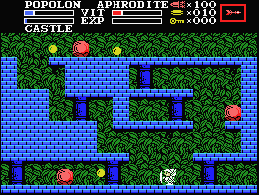 The sequel to Knightmare was released for MSX computers in 1987 (picture on the left).
Majō Densetsu II Daimashikyō Galious (aka The Maze of Galious Knightmare II)
was not a shooter but a side-scrolling action adventure game and followed directly
from the events of the first game - after Popolon rescued his damsel
Aphrodite, he discovers that it was all a malicious plan to lure them away from
the castle and for the evil Galious to kidnap the spirit of their unborn son
Pampas. This sequel, unlike Knightmare, was actually released in Europe
and it was later officially ported by Konami to the Famicom system
(version tested here). An enhanced fan made version called The Maze of Galious
was also released in 2002 by Brain Games for Windows and OSX.
Finally, the third episode followed the same year (1987). The game, called
Shalom Knightmare III, was a Role Playing game and is certainly the oddest
episode in the Knightmare trilogy. It tells the story of a high school kid
who happens to be drawn into the world of a cursed video game called Shalom.
He wakes up in a strange world ruled by a demon king called Gog, and he embarks
on a long adventure helped by a sidekick pig called Butako. The game takes
place decades after the events of the prequel, Popolon and Aphrodite
have passed and Pampas, now old, is the king of the realm. The game was never
released outside of Japan but an English fan translation was released by
SLotman in 2003.
The sequel to Knightmare was released for MSX computers in 1987 (picture on the left).
Majō Densetsu II Daimashikyō Galious (aka The Maze of Galious Knightmare II)
was not a shooter but a side-scrolling action adventure game and followed directly
from the events of the first game - after Popolon rescued his damsel
Aphrodite, he discovers that it was all a malicious plan to lure them away from
the castle and for the evil Galious to kidnap the spirit of their unborn son
Pampas. This sequel, unlike Knightmare, was actually released in Europe
and it was later officially ported by Konami to the Famicom system
(version tested here). An enhanced fan made version called The Maze of Galious
was also released in 2002 by Brain Games for Windows and OSX.
Finally, the third episode followed the same year (1987). The game, called
Shalom Knightmare III, was a Role Playing game and is certainly the oddest
episode in the Knightmare trilogy. It tells the story of a high school kid
who happens to be drawn into the world of a cursed video game called Shalom.
He wakes up in a strange world ruled by a demon king called Gog, and he embarks
on a long adventure helped by a sidekick pig called Butako. The game takes
place decades after the events of the prequel, Popolon and Aphrodite
have passed and Pampas, now old, is the king of the realm. The game was never
released outside of Japan but an English fan translation was released by
SLotman in 2003.
|
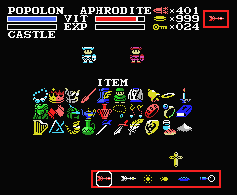 There are many differences between the original MSX game and this
Famicom port. Although the main story is the same, the Famicom
version features fewer dungeons (five instead of ten) but they are much larger
and have been completely redesigned. The port also features a side-scrolling
instead of static screens and larger character sprites. However, this comes at a
There are many differences between the original MSX game and this
Famicom port. Although the main story is the same, the Famicom
version features fewer dungeons (five instead of ten) but they are much larger
and have been completely redesigned. The port also features a side-scrolling
instead of static screens and larger character sprites. However, this comes at a
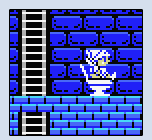 price and items are just listed as plain text (the original game uses graphic
icons, picture on the right). Additionally, at the beginning of the game, blocks can
only be destroyed by collecting a special sword which was not the case in the
original MSX game (blocks were also represented as boulders there).
Various other details also vary, such as the way
you use some items (such as the parasol/umbrella) and the cute little potty
scene (picture on the left) displayed when you pause the game which was omitted from the Famicom
port.
price and items are just listed as plain text (the original game uses graphic
icons, picture on the right). Additionally, at the beginning of the game, blocks can
only be destroyed by collecting a special sword which was not the case in the
original MSX game (blocks were also represented as boulders there).
Various other details also vary, such as the way
you use some items (such as the parasol/umbrella) and the cute little potty
scene (picture on the left) displayed when you pause the game which was omitted from the Famicom
port.
|
|
An English patch for Majō Densetsu II Daimashikyō Galious
was released by Manipulate in 1998 - the protagonists of the game
were renamed Poplon and Venus
(instead of Popolon and Aphrodite).
|
|
Majō Densetsu II Konami Cards
|
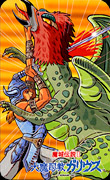
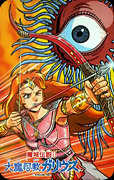
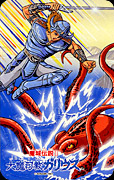
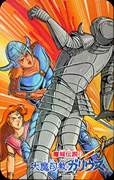

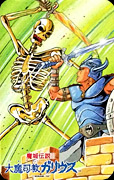
|
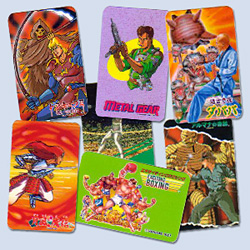 Like several other early Konami games released in the 1980s/1990s, Majō Densetsu II Daimashikyō Galious
included a numbered collector card also known in Japan as コナミ キャラカード (aka 'Konami Chara Cards' or 'Konami Character Cards').
Each card featured an illustration or a snapshot
from the game (picture on the right), and the back of each card showed a serial number as well as the
game's title. They were randomly included with the games and Konami
produced several variations of each card. That's it, each game included a
card from a series related to the game, it is however not known
how many different card variations were made for each game.
Apparently six cards (on average) were produced for each game, except
for Doremikko (1 card), Exciting Boxing (1 card) and Meikyujin Dababa
(which, curiously, only seem to feature five cards).
The list of
Konami games to include such cards are believed to be :
Ai Senshi Nicol (FDS),
Dracula II Noroi no Fuin (FDS),
Arumana no Kiseki (FDS),
Contra (FC),
Doremikko (FDS),
Dragon Scroll (FC),
Exciting Baseball (FDS),
Exciting Basketball (FDS),
Exciting Billard (FDS),
Exciting Boxing (FDS),
Exciting Soccer (FDS),
Falsion (FDS),
Getsu Fūma Den (FC),
Majō Densetsu II Daimashikyō Galious (FC),
Meikyū Jiin Dababa (FDS),
Metal Gear (FC),
Salamander (FC),
Tetsuwan Atom (FC),
Top Gun (FC)
and Wai Wai World (FC).
Like several other early Konami games released in the 1980s/1990s, Majō Densetsu II Daimashikyō Galious
included a numbered collector card also known in Japan as コナミ キャラカード (aka 'Konami Chara Cards' or 'Konami Character Cards').
Each card featured an illustration or a snapshot
from the game (picture on the right), and the back of each card showed a serial number as well as the
game's title. They were randomly included with the games and Konami
produced several variations of each card. That's it, each game included a
card from a series related to the game, it is however not known
how many different card variations were made for each game.
Apparently six cards (on average) were produced for each game, except
for Doremikko (1 card), Exciting Boxing (1 card) and Meikyujin Dababa
(which, curiously, only seem to feature five cards).
The list of
Konami games to include such cards are believed to be :
Ai Senshi Nicol (FDS),
Dracula II Noroi no Fuin (FDS),
Arumana no Kiseki (FDS),
Contra (FC),
Doremikko (FDS),
Dragon Scroll (FC),
Exciting Baseball (FDS),
Exciting Basketball (FDS),
Exciting Billard (FDS),
Exciting Boxing (FDS),
Exciting Soccer (FDS),
Falsion (FDS),
Getsu Fūma Den (FC),
Majō Densetsu II Daimashikyō Galious (FC),
Meikyū Jiin Dababa (FDS),
Metal Gear (FC),
Salamander (FC),
Tetsuwan Atom (FC),
Top Gun (FC)
and Wai Wai World (FC).
|
Game Staff (Copied from the end credits) :
|
STAFF
Program Design
Shinji Kitamoto
Civic Kishiwada
Tsukasa Tokuda
|
|
Graphic Design
Sueiebu Ueyama
Yusaku Kudo
Sound Design
Otoshi Hidenori
Shinkon Shinya
Damian Fujio
Kyouhei Sada
Onigiri Yamako
|
|
Directed by
Shinji Kitamoto
Special Thanks to
Ryouhei Shougaki
Presented by
KONAMI
(c)1987 Konami
|
|
G
O
O
D
I
E
S
|
|
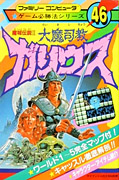
Japanese Guidebook
|
|
|
O
M
A
K
E
|
|

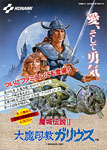
|
|
|
Click on picture to enlarge |
S
E
C
R
E
T
S
|
|
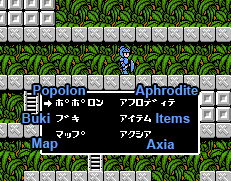 Majō Densetsu II Daimashikyō Galious is complex and incredibly vast, and the various special items
are not described in the game and their function/effect is not always obvious.
Here is a translation of the japanese text as well as short explanations to help you in your quest.
Majō Densetsu II Daimashikyō Galious is complex and incredibly vast, and the various special items
are not described in the game and their function/effect is not always obvious.
Here is a translation of the japanese text as well as short explanations to help you in your quest.
Menu Translation:
ポポロン (Popolon) - Switch to Popolon.
アフロヂィテ (Aphrodite) - Switch to Aphrodite.
ブキ (Buki) - Select sub-weapon.
アイテム (Item) - Use an item.
マップ (Map) - Dungeon's map.
アクシア (Axia) - Tools (they activate automatically when collected).
Weapons & Shields Translation:
ソード (Sword) - Default sword.
モンゴリアンソード (Mongolian Sword) - Can break blocks.
ムラマサソード (Murasama Sword) - Breaks row of blocks.
サーベル (Saber) - Twice the damage.
シールド (Shield) - Default shield.
アストロシールド (Astro Shield) - Deflects projectiles even when using the sword or jumping.
グレートシールド (Great Shield) - Halves damage.
Sub-Weapons Translation:
アロー (Arrow) - Fast arrow.
セラミックアロー (Ceramic Arrow) - Damages several enemies at once and can break blocks.
ファイヤー (Fire) - Crawling fire.
ローリングファイヤー (Rolling Fire) - Crawling fire that follows edges.
マイン (Mine) - Explodes when touched or after a period of time. Damages enemies and destroys blocks.
バルーンボンバー (Balloon Bomb) - Floating bomb.
Items Translation:
セイスイ(Seisui) - Doubles damages against the dungeon boss.
マント(Cloak) - Halves damages taken from the dungeon boss.
マジカルロッド(Magical Rod) - Infinite arrows against the dungeon boss.
マップ(Map) - Map of the visited dungeon.
グレートキー(Great Key) - Increases your maximum life and gives you access to dungeons.
エンゼルリング (Angel Ring) - Sends you back to the record room, or the entrance of a dungeon.
デビルウィング (Devil Wing) - Sends you back to the entrance of one of the visited dungeon.
パラソル (Parasol) - Prevents damage from above (such as bats or boulders).
パペット (Puppet) - Reveals a bridge in last dungeon.
キャンドル (Candle) - Illuminates dark area in 3rd dungeon.
クロス (Cross) - Strengthens arrow so they can be used to damage the final boss.
バイブル (Bible) - Cancels the slowness curse.
ブレスレット (Bracelet) - You can switch to Aphrodite in the women forbidden area.
ネックレス (Necklace) - You can switch to Popolon in the men forbidden area.
イヤリング (Earrings) - Like Aphrodite, Popolon can fire three simultaneous weapons.
ベルト (Belt) - Like Popolon, Aphrodite can destroy blocks in one blow.
ペンダント (Pendant) - Reduces damage taken by Apolon when underwater.
オール (Oar) - Can walk on a specific body of water later in the game.
ランプ (Lamp) - Shows the location of the dungeon's boss on the map.
ブーツ (Boots) - Allows you to pass the geysers/steam.
ボトル (Bottle) - Doubles experience collected when defeating enemies.
ブラックオニオン (Black Onion) - Solidifies lava of the second dungeon.
ソルト (Salt) - Allows you to enter the resurrection room.
マジカルウェア (Magical Wear) - Cancels the reverse-controls curse.
ハープ (Harp) - Reveals the entrance to the final boss chamber.
Spells to summon the dungeon bosses:
Each dungeon boss needs to be summoned by entering a button/direction sequence on the controller. Here are the combinations:
Dungeon 1: AAA BBB
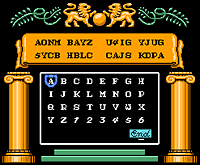 Dungeon 2: Left, Up, Right, Down, Right and Up
Dungeon 2: Left, Up, Right, Down, Right and Up
Dungeon 3: A, Right, B, Left and BBBB
Dungeon 4: ABAABBA, Down, B and Up
Dungeon 5: Right, A, B, Left, A, B, Up, Up, Down and BAA
Invincibility password:
Go to the password screen and enter the following password:
AONM BAYZ U4IG YJUG
5YCB HBLC CAJS KDPA
You can now start the game and you won't take any damage.
|
|
|
|
LK

|
|
Add your Pov here !
|
P
O
V
s
|
|
Majō Densetsu II Daimashikyō Galious is really a hidden
gem and it is anyone's guess as to why it was never released outside of
Japan (although it was probably overshadowed there by Dragon
Quest II released the same year). I find that the difficulty level is
actually really well balanced
(unlike other Konami titles released at the time) and feels fair
most of the time. Well, although the controls are flawless and the balance between
Popolon and Aphrodite is awesome and works surprisingly
well, the game can be brutally challenging to figure out.
The world to explore is incredibly vast and will keep
you busy for a long while, and this is definitively where the game bites.
You can get stuck and walk in circle at times and the function of
some of the items is far from obvious (the black onion solidifies lava, really?).
Honestly, I don't think I would have been able to figure out parts of the game
without a guide.
And yet, dungeon exploration is really what makes this game so fun and
addictive, there's always something to pique your curiosity and
you can revisit each world as often as you want. The
soundtrack is another reason to love Majō Densetsu II, the
tunes are undeniably catchy and suit the game perfectly! All in all,
Majō Densetsu II Daimashikyō Galious is a really well
crafted action/adventure game despite some nasty scratch-your-head moments.
|
|
|
|